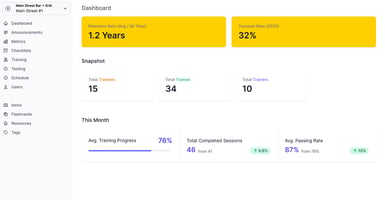Running a restaurant means juggling dozens of priorities every day: delivering hospitality, keeping...
Restaurant Training Best Practices Cheat Sheet
Training your restaurant staff doesn’t need to be chaotic, outdated, or one-size-fits-all. Whether you’re onboarding a first-time server or retraining a seasoned bartender, a structured, human-centered training program is the difference between high turnover and high performance.
Here’s your quick-hit guide to modern restaurant training — built on real-world experience and Shifty’s proven methodology.

1. Train the Way People Learn
Why it matters: Not everyone absorbs information the same way — and that’s especially true in the rush of restaurant life.
Best Practices:
-
Use visual, hands-on, and bite-sized content
-
Incorporate flashcard-style repetition for memory retention
-
Let staff train on their own device, at their own pace — with real-time support
“Shifty was built on the science of how people actually retain information — because reading a 20-page manual at 11PM never worked for anyone.”
2. Make It Role-Specific
Why it matters: Host. Bartender. Line cook. Dishwasher. Same floor, totally different jobs.
Best Practices:
-
Create clear, task-based training paths by role
-
Include real checklists and SOPs used on every shift
-
Allow cross-training only after core responsibilities are mastered
With Shifty, each role gets its own customized learning track — so nobody’s stuck learning someone else’s job on Day 1.
3. Set Clear Milestones (and Celebrate Them)
Why it matters: Staff want to know how they’re doing — and what comes next.
Best Practices:
-
Break training into phases with checkpoints
-
Use digital sign-offs to track progress from both trainers and trainees
-
Recognize early wins like “first solo shift” or “menu mastery”
Shifty makes it easy to track progress and celebrate wins — it’s like giving your team a GPS instead of a paper map.
4. Build Training Into the Schedule
Why it matters: “We’ll train when we have time” usually means “We won’t train at all.”
Best Practices:
-
Schedule dedicated training shifts
-
Pair trainees with top performers, not whoever’s free
-
Use quiet moments for micro-trainings, not fire drills
Shifty’s smart scheduling tools let you assign training shifts, track hours, and reduce burnout — all in one platform.
5. Keep Resources One Tap Away
Why it matters: No one remembers all 20 salad dressings. And that’s okay.
Best Practices:
-
Make materials mobile-friendly and searchable
-
Store updated menus, ingredients, and allergy info in one place
-
Empower staff to self-serve information quickly
With Shifty, everything on the menu they need is already in their pocket — even the specials.
6. Train for Culture, Not Just Tasks
Why it matters: Great hospitality is more than steps of service. It’s about how your team shows up.
Best Practices:
-
Bake your core values into training content
-
Use real-world scenarios to teach decision-making and communication
-
Reinforce a culture of empathy, accountability, and team care
Shifty doesn’t just train people to do their jobs — it trains them to love where they work.
Bonus Tip: Track What’s Working
Training should be a feedback loop, not a one-way street. With Shifty, managers get visibility into what’s working — and what’s not — before issues show up in turnover or guest experience.
Want to See Shifty in Action?
If you’re ready to modernize your training program, empower your team, and build a culture that lasts — let’s talk.


.jpg?height=200&name=SHIFTY%20BLOG%203.3%20(1).jpg)